Edward Hopper Nighthawks I Did It Again
Imagine you are standing on a city street corner, tardily at night. You peer into the window of a diner and see four people inside. Possibly you feel less alone knowing there are other night owls out there, or in this example, Nighthawks. This is the championship of the painting past the American realist artist Edward Hopper, which we will discuss in this article.
Table of Contents
- 1 Artist Abstract: Who Was Edward Hopper?
- 2 Nighthawks by Edward Hopper in Context
- 2.ane Contextual Analysis: A Brief Socio-Historical Overview
- three Formal Analysis: A Cursory Compositional Overview
- three.1 Discipline Thing
- 3.2 Color and Light
- 3.3 Perspective
- 4 A Question Left Unanswered
- 5 Frequently Asked Questions
- five.1 Why Is the Painting Called Nighthawks?
- 5.two What Is the Nighthawks Painting Value?
- 5.3 Is the Nighthawks Painting Based on a Real Identify?
Artist Abstract: Who Was Edward Hopper?
Edward Hopper was born in 1882 in a town called Nyack in New York, United States. He was artistically inclined from a young age, effectually five years onetime. He started drawing sketches and in his teenage years, and used mixed media like oil paints, charcoal, pen-and-ink, and watercolors. He was a educatee at the New York School of Art and Blueprint.
His art teachers included William Merritt Hunt, who too inspired Hopper's before art style. Hopper was also inspired by the styles of Édouard Manet and Edgar Degas, all figures from the French Impressionism art movement. Hopper married Josephine Nivison in 1924 who made a significant bear on on his work and life.
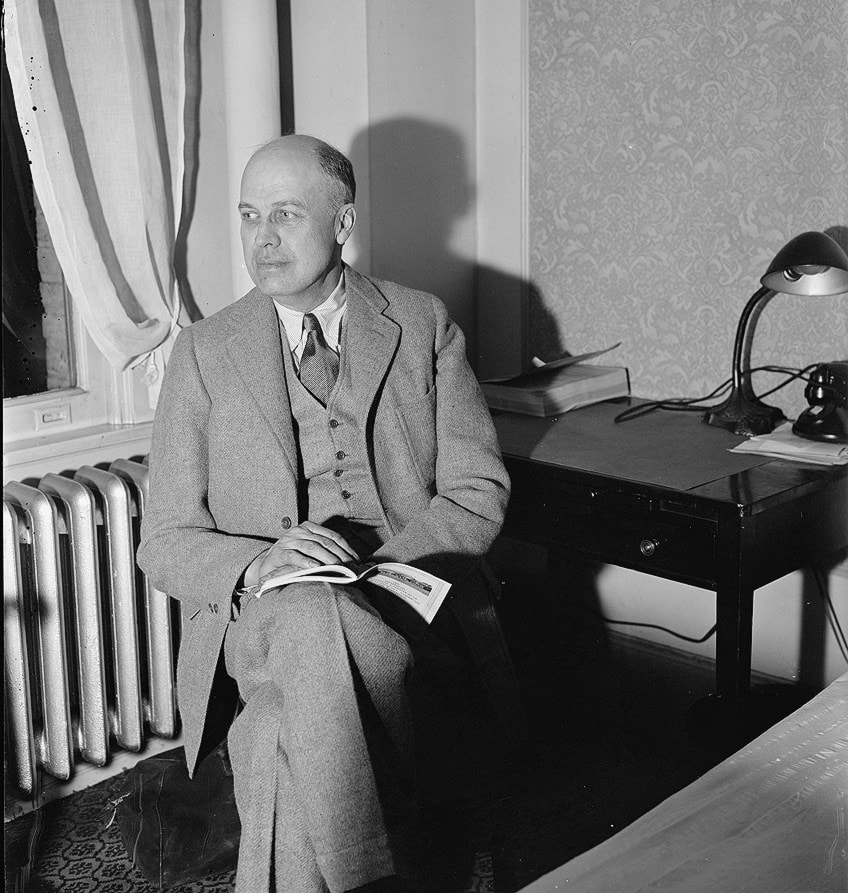 A portrait of Edward Hopper in 1937;Harris & Ewing, photographer, Public domain, via Wikimedia Commons
A portrait of Edward Hopper in 1937;Harris & Ewing, photographer, Public domain, via Wikimedia Commons
Nighthawks by Edward Hopper in Context
Known as ane of the more popular, and widely reproduced, American oil paintings from the Mod 20th-century art is Nighthawks (1942) by Edward Hopper. Oftentimes described as a "timeless" painting, it depicts an every solar day – or every night – scene of four people in a diner. This is something almost everyone can relate to, but this painting touches on deeper meanings than a diner countertop.
In this article we will explore a cursory contextual analysis, we will provide some historical context of how this work is function of the American Realism movement and what may accept influenced Hopper to paint it.
Next, nosotros volition await at a formal assay and Hopper's artistic style in this painting, for case, the way he utilized color to depict lite and dark, his use of line, and of grade, the subject matter – just what are we looking at when we run across four people sitting in a diner in New York City? Below we expect at all these and more.
| Creative person | Edward Hopper |
| Appointment Painted | 1942 |
| Medium | Oil on sail |
| Genre | Genre painting |
| Period / Move | American Realism, Social Realism |
| Dimensions | 84.ane x 152.4 centimeters |
| Series / Versions | Non applicable |
| Where Is It housed? | Art Plant of Chicago |
| What Information technology Is Worth | Sold in 1942 for $3000 |
Contextual Analysis: A Brief Socio-Historical Overview
If we look at the yr and location that Edward Hopper painted Nighthawks, which was 1942 in America, specifically New York as this was where the artist lived, we will notice it gives us more contextual analysis almost the affect of this painting. Keep all these points in listen before nosotros look at this famous diner painting.
World War 2 was in full swing during 1942 and 1941 was the year when Nippon bombed Pearl Harbor. To prevent aircraft bombings American cities too skilful coma drills, which consisted of cities dimming or switching off almost of their lights to minimize the extent of condign a target.
This time undoubtedly impacted all Americans and left them feeling a sense of uncertainty and fearfulness almost their lives and the outcome of the State of war.
Although this was not the sole reason for why Edward Hopper painted Nighthawks, information technology is an of import consideration to deport in mind when looking at his painting every bit it is depicted with a sense of quiet, dimness, and eeriness that tin can easily exist attested to the prevalent mood of that fourth dimension, which was undoubtedly 1 of foreboding.
 Nighthawks (1942) past Edward Hopper;Edward Hopper, Public domain, via Wikimedia Commons
Nighthawks (1942) past Edward Hopper;Edward Hopper, Public domain, via Wikimedia Commons
New York during the 1940s was a humming city full of life and evolution. The urbanized city life in New York was also a common way of life with thousands of people living in neighborhoods and apartment blocks going about their business. We cannot help but wonder what peoples' lives were like during the 1940s – was it similar today?
If annihilation, we tin can estimate that living in a large city like New York had, and still has, its upsides and downsides whether you are alone or not. What was the existential quality for an inhabitant of New York, especially someone who lived during a time of rapid modernization in culture and technology?
A Bit More About Hopper
Hopper was born and grew upward in the small village of Nyack in New York and moved to Greenwich Village in New York City in 1913 where he stayed for the remainder of his life. He worked as an illustrator for a big function of his career in New York Urban center and sold his showtime painting titled Sailing (1911) in 1913 at the Armory Prove in New York; he merely sold other paintings years later.
He made three trips to Europe before he settled in Greenwich Hamlet and slowly developed his career as an artist. He visited cities similar Paris and Amsterdam and experienced what fine art was like there.
During his time in Paris, Hopper was notably influenced by the Impressionists, namely by artists similar Édouard Manet, Edgar Degas, Pierre-Auguste Renoir, Camille Pissarro, among others and how they painted scenes of modern life living in the urban center. Hopper also reportedly painted street scenes during his visits in Paris, a style chosen en plein air, which means "in the open air"; he also painted from live models.
Hopper was also moved by Rembrandt van Rijn's The Nighttime Watch (1642) housed in the Rijksmuseum in Amsterdam. Hopper is reported to take said the post-obit about Rembrandt'due south The Night Lookout painting: "[information technology is the] almost wonderful matter of his I have seen, its by belief in its reality – it almost amounts to deception".
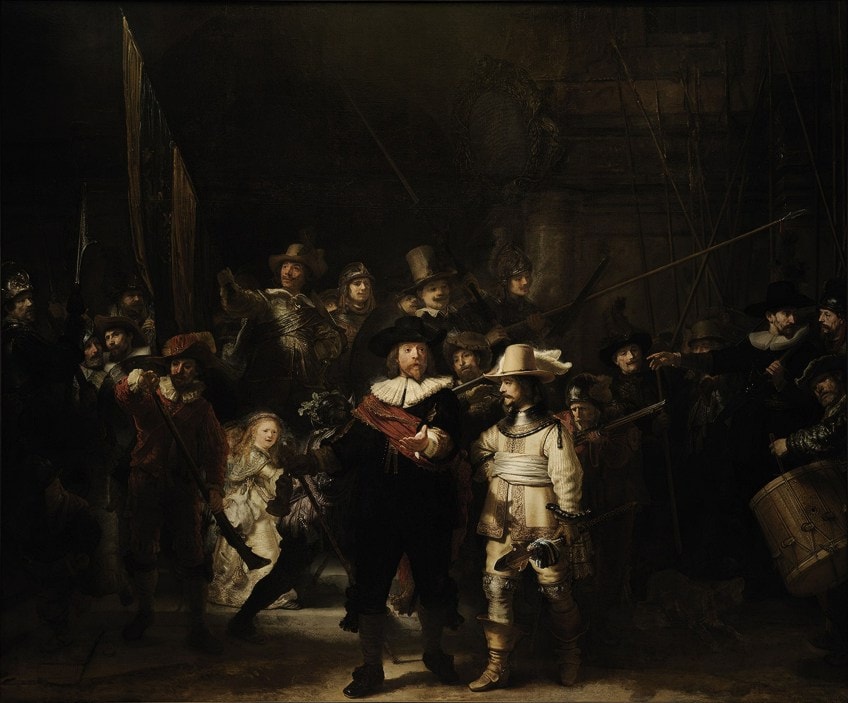 The Night Watch (1642) past Rembrandt van Rijn; Rembrandt, Public domain, via Wikimedia Eatables
The Night Watch (1642) past Rembrandt van Rijn; Rembrandt, Public domain, via Wikimedia Eatables
Hopper loved his fourth dimension in Paris and considered information technology ane of the most beautiful cities in the earth. He also considered himself an Impressionist throughout his career. Although he has primarily been categorized as an American Realist painter, he was likewise drawn to the realist genre of painting.
Hopper was also influenced by Charles Meryon, who was a famous French engraver and well-known for his Gothic style of etches of Paris.
Hopper's painting procedure was apparently very slow, and it took him considerable fourth dimension to detect the right subject affair. He is also reported to have stated that his painting "crystalized" when he started printmaking in 1915. His etchings were notably mysterious in their mood, a proficient example of this is his Nighttime Shadows (1921), which depicts an aerial view of a solitary figure walking on a street corner in New York.
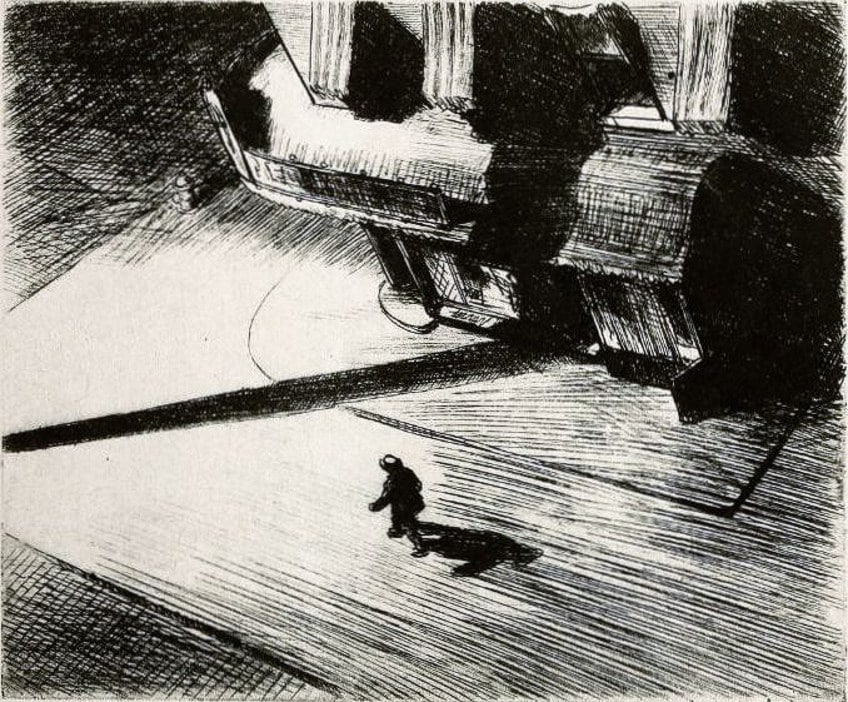 Nighttime Shadows etching past Edward Hopper, 1922;Edward Hopper, Public domain, via Wikimedia Commons
Nighttime Shadows etching past Edward Hopper, 1922;Edward Hopper, Public domain, via Wikimedia Commons
This shadowy-based style was also influenced past moving picture noir during the 1940s. Films and theatre were important parts of Hopper's life and ultimately his art manner. He loved watching films and visiting theatres, in fact, his instructor from the Ashcan Schoolhouse, Robert Henri, motivated him to do this to too notice life and people around him.
Hopper is reported to take said, "When I don't feel in the mood for painting, I go to the movies for a calendar week or more. I proceed a regular film binge".
It was in 1923 when Hopper and Josephine Nivison met each other once again, previously they met through Robert Henri every bit students. The two ended up marrying in 1924 and would be together for the rest of their lives.
During the 1930s Hopper's artistic career started flourishing, he sold around 30 paintings and around xviii watercolors to prominent art museums like the Metropolitan Museum of Fine art and the Whitney Museum of American Art. The Museum of Modern Art exhibited a retrospective of Hopper's piece of work during 1933 subsequently accessioning his painting Firm past the Railroad (1925) as part of their permanent collection in 1930.
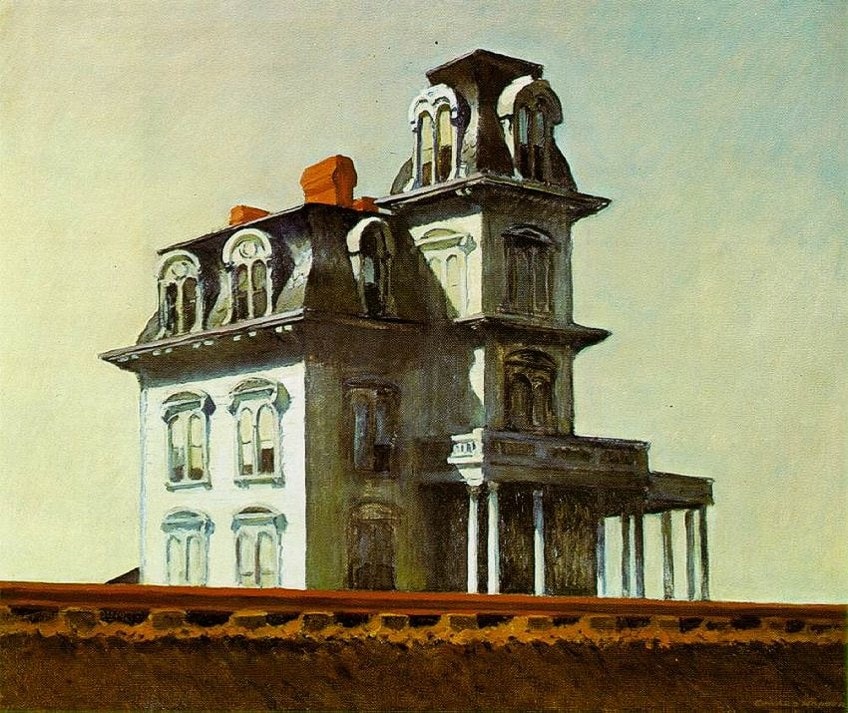 Firm past the Railroad (1925) past Edward Hopper;Edward Hopper, Public domain, via Wikimedia Commons
Firm past the Railroad (1925) past Edward Hopper;Edward Hopper, Public domain, via Wikimedia Commons
Hopper certainly received artistic recognition and acclamation during the 1930s all the style to the 1960s from the years of struggle and seemingly uneventful artistic career. He continued to create paintings with the characteristic theme of solitary figures amidst various urban landscapes, often with an open-ended narrative, leaving it up to united states, his viewers, to determine the outcome of his painted characters.
Jo and Edward are described as having lived a "frugal" lifestyle and would spend their money on motion-picture show or theatre tickets and eating out at inexpensive diners. The couple also traveled to various places like New England where they would stay and paint, including their house in Southward Truro in Massachusetts.
The couple was known to accept a difficult relationship, but, notwithstanding, Jo was Hopper's model for his paintings and gave his artistic career a heave in many ways. Hopper was also known as an introvert and did non notice social aspects of life easy to handle. He lived very inwardly, a lover of art in all forms, painting, literature, and flick.
He was a conscientious artist, and, with Jo'south input, his paintings were extensively planned before their execution, much like the delicate planning that goes into directing a movie.
Formal Analysis: A Cursory Compositional Overview
Beneath we zoom in on Hopper's acclaimed painting Nighthawks (1942). Nosotros will explore its subject matter and some of the stylistic elements Hopper employed in its cosmos, peculiarly his apply of lighting and perspective.
Discipline Matter
In Hopper'due south Nighthawks painting we meet a diner with four people inside, on what appears to be a street corner. There are three men and ane woman, of which Hopper and his married woman Jo were the main models. Surrounding the diner are other flat buildings reminiscent of a street in New York City. The scene takes place during the night with no other sign of life other than the 4 figures within.
Although this scene appears very simplified and solitary, there are detailed props and cues that give us a scene filled with life.
Let us start with the diner. There is no door indicated for the diner, the only door nosotros encounter is the one within that appears to exist the kitchen door. The windows almost become an enclosed frame for the iv figures within, leading our attention to them. Furthermore, the diner is the only source of light besides lighting up the pavement exterior, further highlighting the figures inside.
Above the diner, we see an advertising, or perhaps the name of the diner, that says, "Only 5c Phillies". The residual of the advertisement words are partially cut off by the composition, but it appears to read "America's No 1 Cigar".
 A detail of Nighthawks (1942) past Edward Hopper;Edward Hopper, Public domain, via Wikimedia Commons
A detail of Nighthawks (1942) past Edward Hopper;Edward Hopper, Public domain, via Wikimedia Commons
The Four Night Hawks
There are four figures within, three sit around the wooden countertop, which takes up most of the infinite within the diner and appears well-nigh triangular in its shape. The waitron, who wears a white uniform and hat, is on the inside of this space, behind the counter. He is looking ahead at something with his mouth partially open in a grimace of some sort busy with something backside the counter.
He is the just figure out of the four with a more than animated facial expression.
There are two figures sitting side by side to each other on the other side of the counter contrary the waitron. From our view, the woman sits on the correct and the homo is next to her (our left). She has reddish-chocolate-brown colored pilus, wears a red blouse, and holds upwardly what is possibly a sandwich in her correct mitt (our left). The man side by side to her wears a steel grey hat with a navy suit and tie, a light blue shirt underneath, and a cigarette in his right hand (our left), his hands resting on the countertop.
 A particular of the figures in Nighthawks (1942) by Edward Hopper;Edward Hopper, Public domain, via Wikimedia Commons
A particular of the figures in Nighthawks (1942) by Edward Hopper;Edward Hopper, Public domain, via Wikimedia Commons
Although these two figures are sitting closely side by side to one another they announced to be worlds apart. Their left easily (our right) are both resting on the countertop and at first glance, it would announced they are touching, simply if you look closer, there is no intention for their hands to connect despite the concrete closeness; both announced deep in idea or mayhap just a general angst?
The other figure sits on the other side of the counter with his dorsum to usa. All we know nearly this effigy is that he wears a similar hat to the other man and a night-colored suit. He holds a glass in his right hand and there appears to be a folded newspaper resting under his left elbow. He sits on the second bar stool from the outer border of the counter; there are 7 bar stools forth the counter.
The Props
The diner seems to be the main focal indicate of the Nighthawks painting, but information technology would somehow non have the aforementioned impact without the props surrounding the four figures. If we look at the countertop, we see the meticulous attention to detail in the coffee cups, spectacles, napkin holder, and table salt and pepper shakers.
There is too an extra drinking glass almost the 5th stool of the counter – who does this belong to?
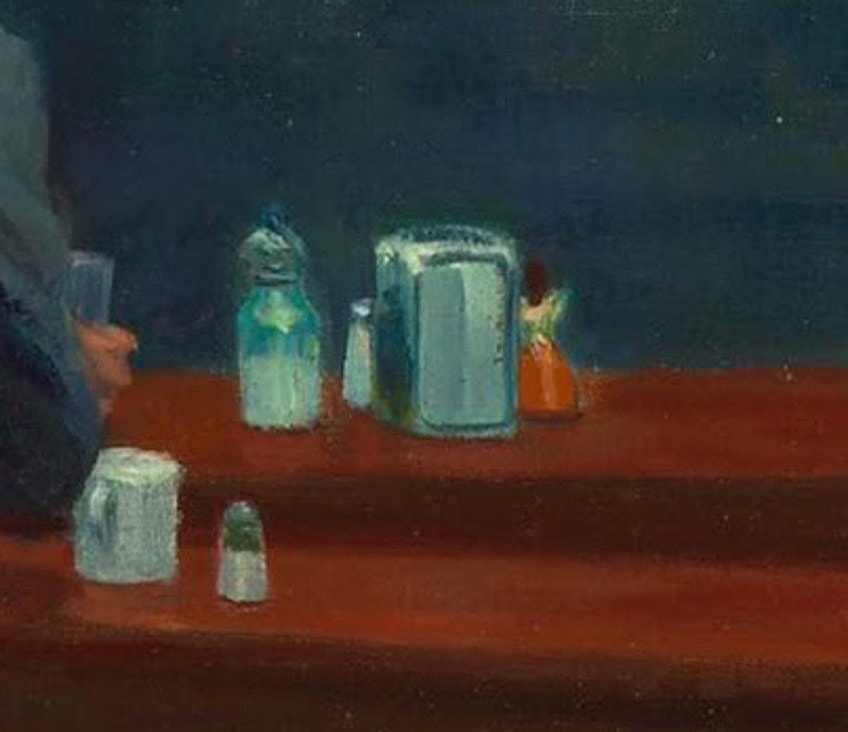 A detail of the props in Nighthawks (1942) by Edward Hopper;Edward Hopper, Public domain, via Wikimedia Eatables
A detail of the props in Nighthawks (1942) by Edward Hopper;Edward Hopper, Public domain, via Wikimedia Eatables
Near the kitchen door to the far-left corner inside the diner, the just corner we tin visibly see inside the diner, we also notice two large silvery coffee urns including how much coffee is in each; the left urn appears to exist on empty and the right urn has about a tertiary of coffee left in it.
 Another particular of the props in Nighthawks (1942) by Edward Hopper;Edward Hopper, Public domain, via Wikimedia Commons
Another particular of the props in Nighthawks (1942) by Edward Hopper;Edward Hopper, Public domain, via Wikimedia Commons
The setting outside the diner is darker, the interior spaces beneath and in a higher place in the building across the street are all airtight indicating no light or life. All we run across through the windows inside the space below is a cash register on a wooden counter, suggesting it is a store. To a higher place, the forest-light-green blinds of the vertical-rectangular windows appear half shut.
Color and Lite
Edward Hopper utilizes colour to depict ambient light in the Nighthawks painting, we see this primarily in the fluorescent calorie-free in the diner, which was a popular and new type of lite form during the 1940s. This light seemingly works similar a spotlight on the central figures, almost equally if it is a calorie-free on a theatre stage highlighting the principal characters.
The yellow ceiling makes the light just a footling warmer.
Furthermore, if we zoom in on the figures' skin tones, nosotros see the furnishings of the calorie-free, which gives them a "washed out" wait. The lite moves onto the pavement outside, illuminating the surrounding surface area, but as nosotros movement farther into the street, it becomes darker suggesting more than lifelessness around the diner.
 The lighting in Nighthawks (1942) by Edward Hopper;Edward Hopper, Public domain, via Wikimedia Commons
The lighting in Nighthawks (1942) by Edward Hopper;Edward Hopper, Public domain, via Wikimedia Commons
Additionally, we do not see whatever other form of low-cal other than the diner light, which also reaches its mode into the shop across the street and some of the windows in a higher place it. Hopper depicted light in a realistic manner – this is something nosotros would run into if we were standing on a darkened street corner looking in on an illuminated diner.
Depicting low-cal was one of Hopper'south goals and loves. We run across this non only in the way he depicts artificial man-made lite but sunlight besides in many of his other paintings. Some include Rooms by the Sea (1951), Morning time Sun (1952), and 2nd Story Sunlight (1960), among others.
He is remembered equally proverb, "I gauge I'm not very human. All I actually desire to do is pigment lite on the side of a house".
 2nd Story Sunlight (1960) past Edward Hopper;Edward Hopper, Public domain, via Wikimedia Eatables
2nd Story Sunlight (1960) past Edward Hopper;Edward Hopper, Public domain, via Wikimedia Eatables
Perspective
The way Hopper utilized perspective in his Nighthawks painting is significantly interesting and artistically astute. He created numerous preparatory sketches non merely for the characters and props but also for the compositional layout and perspective. As noted earlier, the countertop inside the diner appears like a triangular shape, which echoes the triangularity of the street corner the diner is located on.
The entire diner is also viewed from an angle through the perspective of an unknown viewer, which is presumably us; there is an chemical element of voyeurism in the mode Hopper depicted the Nighthawks scene. Furthermore, Hopper utilized the placement of horizontal and vertical lines to create a focal point, which is the diner.
If nosotros look at the diner to the right side of the composition, the horizontal lines from the top and lesser of the structure converge to a focal point somewhere in the distance to the left that we cannot meet.
A Question Left Unanswered
The Nighthawks' painting value around 1942, the twelvemonth information technology was sold to the Art Institute of Chicago, was $3000. It was reportedly sold a few months later it was completed in Jan of the same twelvemonth. Hopper stated that the diner painting was "suggested by a eating place on Greenwich Avenue where ii streets meet", withal, this diner has been widely searched for equally a location.
Furthermore, this famous diner painting has been the inspiration for modern-day pop culture, from movies, literature, paintings, and many other artistic modalities. For instance popular Television receiver series like The Simpsons, CSI: Crime Scene Investigation, Joyce Carol Oates' poem titled Edward Hopper's Nighthawks, 1942, the music anthology titled Nighthawks at the Diner (1975) by Tom Waits, and many others.
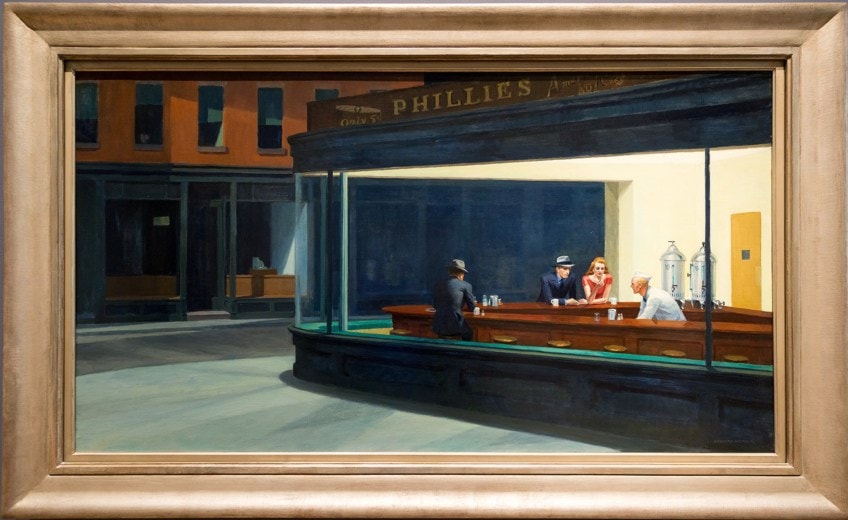 Edward Hopper's Nighthawks (1942), housed at the Fine art Establish of Chicago; Edward Hopper, Public domain, via Wikimedia Commons
Edward Hopper's Nighthawks (1942), housed at the Fine art Establish of Chicago; Edward Hopper, Public domain, via Wikimedia Commons
The principal "buzz words" around this painting include timelessness and loneliness because information technology shows us the realities of living in a city brimming with culture and people, withal the other side of it can exit i feeling completely isolated in its throes. Hopper ironically did not solely aim to depict this aspect; he was reported as saying, "unconsciously, probably, I was painting the loneliness of a large urban center". We tin believe this equally he lived in the metropolis and must have felt similar feelings.
Hopper depicted a scene so empty that it was filled with potential, this potential has been explored by so many in the form of figuring out what the scene ways and creating stories for the four characters. There accept been many attempts at answering the inevitable questions that back-trail this painting, namely, who are the people in this painting, where exercise they come from, and where are they going? A question Hopper left unanswered – a question he left on the table for us to answer.
Take a look at ourNighthawkspainting webstory here!
Oft Asked Questions
Why Is the Painting Called Nighthawks?
Nighthawks by Edward Hopper was given its proper noun considering of the precipitous shape of the homo's nose sitting next to the woman. His nose resembles that of a bird's beak, and it was suggested by Jo Hopper (Edward Hopper's wife) that "Nighthawks" would be a good proper noun for the painting.
What Is the Nighthawks Painting Value?
The Nighthawks painting value was $3000 in 1942, the year it was sold to the Art Found of Chicago for the above toll and simply a few months later on its completion. Yet, the value of this painting has undoubtedly increased since the 1940s.
Is the Nighthawks Painting Based on a Real Place?
A widely searched diner, Hopper stated that the diner painting was "suggested past a eatery on Greenwich Artery where two streets meet". However, information technology is believed that this diner was based on various diners.
Source: https://artincontext.org/nighthawks-edward-hopper/
0 Response to "Edward Hopper Nighthawks I Did It Again"
ارسال یک نظر